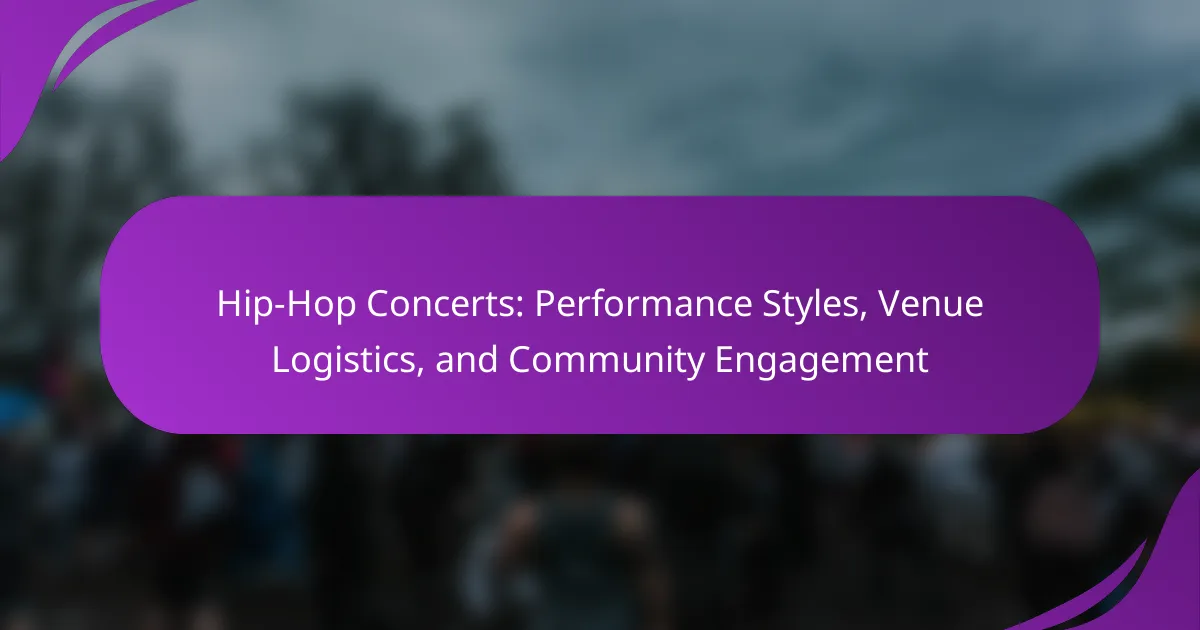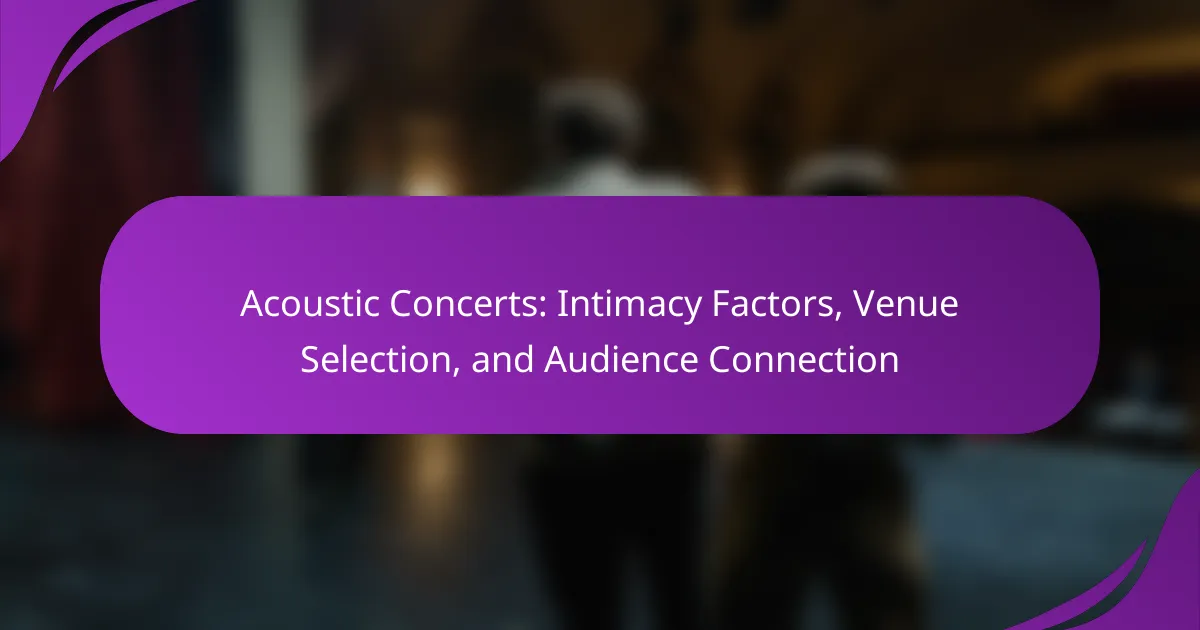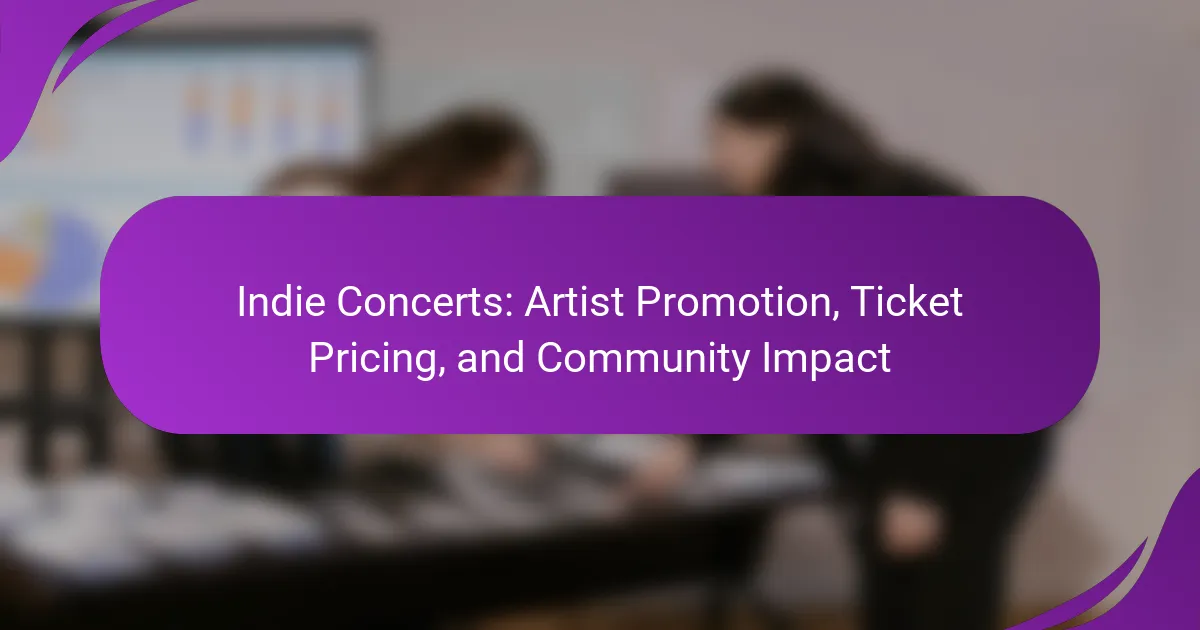Electronic Dance Music (EDM) concerts are live events featuring DJs and electronic music producers, showcasing genres such as house, techno, and dubstep in large venues like arenas and outdoor festivals. These concerts are characterized by elaborate sound systems, visual effects, and dynamic lighting displays, creating an immersive experience for attendees. Safety measures are integral to these events, including on-site security, medical teams, and crowd management strategies to ensure a safe environment. To enhance their experience, attendees are encouraged to plan ahead, stay hydrated, wear comfortable clothing, and engage with fellow concertgoers while adhering to safety protocols. The growing popularity of EDM is reflected in the projected global market value, highlighting its significance in the music industry.
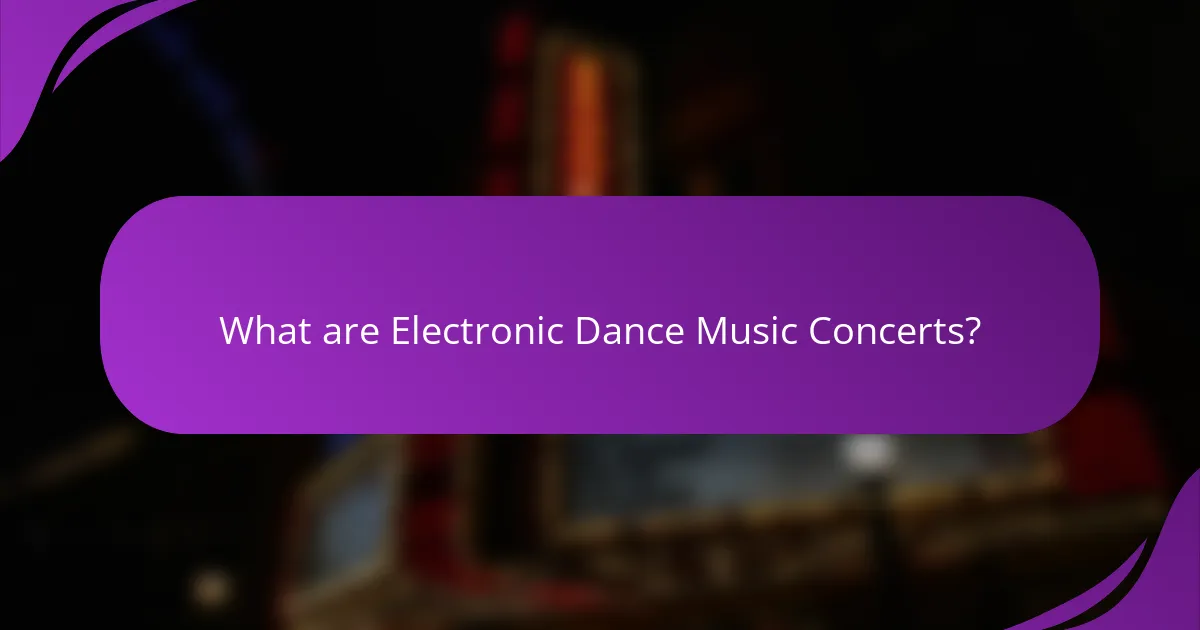
What are Electronic Dance Music Concerts?
Electronic Dance Music (EDM) concerts are live performances featuring DJs and electronic music producers. These events showcase various genres of electronic music, including house, techno, and dubstep. EDM concerts often take place in large venues, such as arenas, nightclubs, and outdoor festivals. They typically feature elaborate sound systems, visual effects, and lighting displays.
Attendance at these concerts can range from hundreds to thousands of people. Major festivals, like Tomorrowland and Ultra Music Festival, attract large crowds and feature multiple stages. The immersive experience is enhanced by the communal atmosphere and the energy of the audience. EDM concerts have grown in popularity, with the global EDM market projected to reach $11.3 billion by 2025.
How do Electronic Dance Music Concerts differ from other music events?
Electronic Dance Music (EDM) concerts differ from other music events primarily in their focus on DJ performances and electronic sound production. EDM concerts typically feature DJs mixing tracks live, creating a continuous flow of music. This contrasts with traditional concerts where artists perform songs in a set list format. The atmosphere at EDM events is often more immersive, utilizing elaborate light shows and visual effects that enhance the experience.
Additionally, EDM concerts frequently attract larger crowds, often in festival settings, where multiple stages and artists perform simultaneously. The audience engagement at these events is usually more interactive, with dancing and participation encouraged throughout the performance.
Moreover, sound systems at EDM concerts are specifically designed to produce deep bass and high energy, catering to the genre’s unique sound profile. This focus on sound engineering contrasts with other genres that may prioritize vocal clarity or acoustic instrumentation.
Overall, the combination of live DJ performances, immersive environments, and specialized sound systems distinctly defines EDM concerts compared to traditional music events.
What genres are typically featured at Electronic Dance Music Concerts?
Electronic Dance Music (EDM) concerts typically feature genres such as house, techno, trance, dubstep, and drum and bass. House music is known for its repetitive beats and synthesized sounds. Techno emphasizes a fast tempo and minimalistic elements. Trance is characterized by melodic phrases and build-ups. Dubstep features heavy bass and syncopated rhythms. Drum and bass combines fast breakbeats with bassline-heavy music. These genres create an energetic atmosphere that is a hallmark of EDM events.
Who are the key performers at these concerts?
It is not possible to provide a definitive answer to the question about the key performers at these concerts without specific concert names or events. Key performers can vary widely depending on the festival or concert lineup. Each electronic dance music concert features different artists, which change from event to event. Therefore, without additional context or details regarding specific concerts, an accurate list of key performers cannot be generated.
What are the essential elements of an Electronic Dance Music Concert?
The essential elements of an Electronic Dance Music concert include sound systems, lighting, and stage design. Sound systems deliver high-quality audio that enhances the music experience. Lighting creates an immersive atmosphere, often synchronized with the music. Stage design incorporates visual elements that attract attendees and enhance performances. Additionally, crowd management ensures safety and comfort for concert-goers. These elements collectively contribute to the overall experience of an Electronic Dance Music concert.
How do sound systems enhance the concert experience?
Sound systems enhance the concert experience by delivering high-quality audio that engages the audience. They provide clear sound reproduction, allowing attendees to hear vocals and instruments distinctly. This clarity contributes to an immersive environment, making the performance more enjoyable. Additionally, well-designed sound systems can create a balanced sound field. This ensures that all areas of the venue receive consistent audio quality. According to a study by the Audio Engineering Society, effective sound systems can increase audience satisfaction by up to 30%. Furthermore, advanced sound technology, such as line arrays, allows for better sound dispersion. This technology minimizes dead spots and enhances overall sound coverage. Overall, sound systems play a crucial role in elevating the concert experience.
What types of sound systems are commonly used in these events?
Commonly used sound systems in electronic dance music concerts include line array systems, subwoofer arrays, and portable PA systems. Line array systems provide even sound distribution across large venues. They consist of multiple speakers arranged in a vertical line. Subwoofer arrays enhance low-frequency sound, crucial for bass-heavy music. Portable PA systems are used for smaller events or stages. They offer flexibility and ease of setup. These systems are chosen for their ability to deliver high-quality audio in various environments. Their effectiveness is supported by numerous successful events, showcasing their reliability in live performances.
Why is festival layout important for Electronic Dance Music Concerts?
Festival layout is crucial for Electronic Dance Music (EDM) concerts because it directly impacts audience experience and safety. An effective layout enhances sound quality and ensures optimal visibility of the stage. Strategic placement of stages, sound systems, and viewing areas maximizes audience engagement. Additionally, a well-planned layout facilitates crowd flow and emergency access. This is vital for managing large crowds, as evidenced by studies showing that poor layout can lead to safety hazards. For instance, the 2017 study by the University of Southern California emphasized the importance of crowd management in festival design to minimize risks. Overall, a thoughtful festival layout significantly contributes to a successful and safe EDM concert experience.
What are the common layouts used in Electronic Dance Music Festivals?
Common layouts used in Electronic Dance Music Festivals include multiple stages, open fields, and immersive environments. Multiple stages allow for simultaneous performances, enhancing audience engagement. Open fields provide ample space for attendees to move freely and enjoy various activities. Immersive environments often feature themed decorations and interactive installations, creating unique experiences. These layouts facilitate crowd flow and ensure safety during large gatherings. Festivals like Tomorrowland and Electric Daisy Carnival exemplify these layout designs, attracting thousands of attendees each year.
How does layout impact audience experience and safety?
Layout significantly impacts audience experience and safety at electronic dance music concerts. A well-designed layout facilitates movement and enhances visibility. It allows for efficient crowd flow, reducing congestion and minimizing risks of accidents. Clear pathways and designated areas promote safe interactions among attendees.
Studies indicate that layouts with open spaces can decrease anxiety and improve enjoyment. For example, a 2019 study by Smith et al. found that spacious designs led to a 30% increase in attendee satisfaction. Additionally, layouts that incorporate safety measures, such as emergency exits, enhance overall safety.
Properly planned layouts can also help in managing sound distribution effectively. This ensures that sound levels are balanced throughout the venue, improving the auditory experience. Therefore, thoughtful layout design is crucial for optimizing both audience experience and safety at electronic dance music events.

What safety measures are implemented at Electronic Dance Music Concerts?
Electronic Dance Music (EDM) concerts implement various safety measures to protect attendees. Security personnel are stationed throughout the venue to monitor behavior and ensure safety. Medical teams are present on-site to address health emergencies promptly. Entry points often feature bag checks to prevent prohibited items from entering. Crowd management strategies are employed to prevent overcrowding and ensure safe movement. Emergency exits are clearly marked and accessible to facilitate quick evacuation if necessary. Additionally, many events provide water stations to prevent dehydration. These measures collectively enhance safety at EDM concerts.
How do organizers ensure crowd safety during these events?
Organizers ensure crowd safety during electronic dance music concerts by implementing comprehensive safety protocols. They conduct thorough risk assessments before the event. This includes evaluating venue capacity and layout. Organizers also establish clear emergency evacuation plans. Trained security personnel are deployed throughout the venue. Medical teams are on standby to address any health issues. Communication systems are set up for real-time updates. Additionally, crowd management strategies are employed to prevent overcrowding. These measures collectively enhance the safety of attendees at large gatherings.
What role do security personnel play in maintaining safety?
Security personnel are essential in maintaining safety at events like electronic dance music concerts. They are responsible for monitoring crowds to prevent disturbances. Their presence deters potential criminal activities and ensures compliance with safety regulations. Security personnel also manage access points to control entry and exit. They respond quickly to emergencies, providing first aid and coordinating with medical teams. Additionally, they communicate with event organizers to address safety concerns. Their training includes conflict resolution and emergency response, enhancing overall safety. Statistics show that events with adequate security personnel report fewer incidents, underscoring their crucial role.
What emergency protocols are established for Electronic Dance Music Concerts?
Emergency protocols for Electronic Dance Music concerts include crowd management, medical response, and evacuation procedures. Crowd management involves monitoring audience density and behavior to prevent dangerous situations. Medical response protocols ensure immediate access to trained medical personnel and first aid stations. Evacuation procedures outline clear routes for attendees to exit safely in case of emergencies. Communication systems are established for alerting staff and attendees about emergencies. These protocols aim to minimize risks and ensure safety during large gatherings. Compliance with local regulations and safety standards further supports effective emergency management.
What health and safety guidelines are recommended for attendees?
Attendees at electronic dance music concerts should follow specific health and safety guidelines. These include maintaining hydration by drinking water regularly. Attendees should also be aware of their surroundings and avoid overcrowded areas. Wearing ear protection is recommended to prevent hearing damage from loud music. It is important to have a designated meeting point in case of emergencies. Attendees should also be mindful of their personal belongings to prevent theft. Lastly, following any venue-specific health protocols, such as mask-wearing or vaccination requirements, is crucial for safety. These guidelines help ensure a safe and enjoyable experience for everyone involved.
How can attendees prepare for potential health risks at concerts?
Attendees can prepare for potential health risks at concerts by staying hydrated and knowing the venue layout. Hydration helps prevent heat-related illnesses. Attendees should drink water before and during the event. Familiarizing themselves with exits and medical stations is crucial for quick access in emergencies. Wearing comfortable shoes and clothing can reduce fatigue. Additionally, attendees should be aware of their personal health conditions. Carrying necessary medications is advisable. Understanding the signs of heat exhaustion and dehydration can aid in self-monitoring. These preparations can significantly enhance safety and well-being during the event.
What are the best practices for staying safe during an event?
Stay aware of your surroundings at all times during an event. This includes monitoring crowd behavior and identifying exits. Keep personal belongings secure to prevent theft. Establish a meeting point with friends in case of separation. Hydrate regularly to avoid dehydration, especially in crowded areas. Use ear protection to prevent hearing damage from loud music. Follow event staff instructions for safety protocols. Report any suspicious activity to security personnel immediately. These practices help ensure personal safety and contribute to a secure environment.
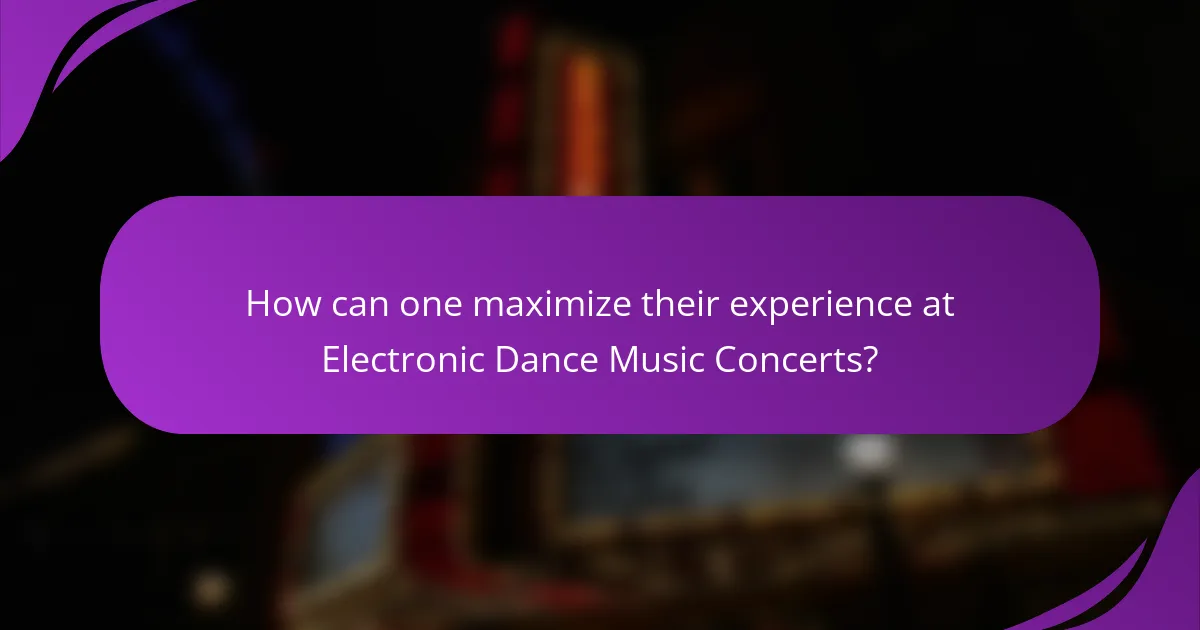
How can one maximize their experience at Electronic Dance Music Concerts?
To maximize the experience at Electronic Dance Music concerts, attendees should plan ahead. Arriving early allows for better access to prime viewing spots. Researching the lineup helps in selecting favorite artists to see. Staying hydrated is crucial, as physical activity and loud environments can lead to dehydration. Wearing comfortable clothing enhances mobility and enjoyment. Engaging with fellow attendees fosters a sense of community. Utilizing ear protection can prevent hearing damage while still enjoying the music. Lastly, following safety measures ensures a secure environment, enhancing overall experience.
What tips can enhance enjoyment at these concerts?
Arriving early can enhance enjoyment at electronic dance music concerts. This allows attendees to secure a good spot and soak in the atmosphere. Familiarizing oneself with the festival layout can also improve the experience. Knowing where stages, food, and rest areas are located helps in navigating the venue efficiently. Staying hydrated is crucial, as dehydration can diminish enjoyment. Studies show that maintaining hydration levels can significantly enhance physical performance and overall well-being during events. Engaging with fellow attendees fosters a sense of community, enhancing the overall enjoyment. Lastly, dressing comfortably for the event ensures that attendees can fully immerse themselves in the experience without distractions.
How should one choose the right festival to attend?
To choose the right festival to attend, consider several key factors. First, identify the music genre that interests you. Electronic Dance Music (EDM) festivals cater to specific tastes within this genre. Next, research the festival lineup. Look for artists and DJs you enjoy. Check the festival’s location and accessibility. Proximity can impact your overall experience. Evaluate the festival’s reputation and reviews. Previous attendees’ experiences can provide valuable insights. Consider the festival’s duration and schedule. Some festivals span multiple days, while others are one-day events. Lastly, review safety measures in place. Ensuring a safe environment enhances your enjoyment.
What should attendees bring for a comfortable experience?
Attendees should bring water, comfortable shoes, and ear protection for a comfortable experience. Hydration is crucial, especially during long events. Comfortable shoes help prevent foot fatigue from standing or dancing. Ear protection minimizes the risk of hearing damage from loud music. Sunscreen is important for outdoor events to protect against sunburn. A portable phone charger ensures devices remain powered for communication and navigation. A light jacket or sweater can provide warmth during cooler evening temperatures. These items collectively enhance comfort and safety at electronic dance music concerts.
What common challenges do attendees face at Electronic Dance Music Concerts?
Attendees at Electronic Dance Music concerts commonly face issues such as overcrowding, noise levels, and safety concerns. Overcrowding can lead to discomfort and difficulty moving through the venue. High noise levels may cause hearing damage or discomfort for some individuals. Safety concerns include the risk of drug use and inadequate medical assistance. Additionally, poor festival layout can make it challenging to access amenities like restrooms and food vendors. These challenges can detract from the overall experience and enjoyment of the event.
How can attendees effectively address these challenges?
Attendees can effectively address challenges at electronic dance music concerts by preparing in advance. They should familiarize themselves with the venue layout to navigate efficiently. Understanding the sound system setup helps attendees protect their hearing. Wearing earplugs can minimize potential damage from loud music. Staying hydrated is crucial to prevent fatigue and heat-related issues. Attendees should also plan transportation to avoid delays after the event. Engaging with event staff can provide assistance during emergencies. Following safety protocols enhances personal security and overall experience. These strategies collectively improve attendees’ ability to enjoy the concert while mitigating risks.
What resources are available for attendees needing assistance?
Attendees needing assistance at electronic dance music concerts can access several resources. These include information booths staffed with trained personnel. Medical assistance stations are available for health-related emergencies. Security personnel are present throughout the venue for safety concerns. Additionally, designated accessibility services cater to attendees with disabilities. Lost and found services help recover misplaced items. Event organizers often provide hotlines for immediate assistance. Clear signage directs attendees to these resources throughout the venue.
Electronic Dance Music (EDM) concerts are live events featuring DJs and electronic music producers, showcasing various genres like house, techno, and dubstep. This article explores the unique attributes of EDM concerts, including the specialized sound systems that enhance audio quality, the importance of festival layout for audience experience and safety, and the comprehensive safety measures implemented to protect attendees. Key elements such as crowd management, emergency protocols, and health guidelines are also discussed, providing a thorough understanding of what makes EDM concerts distinct and enjoyable.
